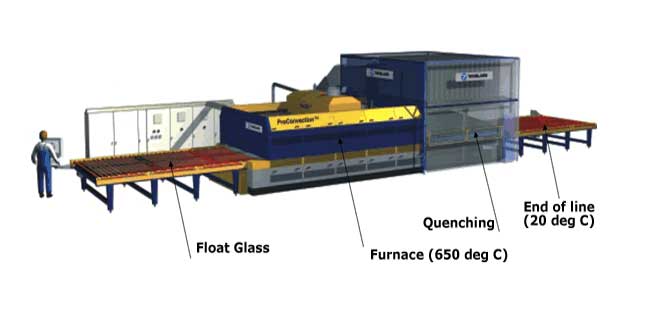Home » Blog » Toughened glass - how is it manufactured
Posted on : 11-03-2024 Author : Keerti Upadhyay

Toughened glass, also known as tempered glass, undergoes a specialized heat treatment process to enhance its strength and durability. The tempering process involves several key steps:
Cutting: The glass sheets are first cut to the desired size and shape using precision cutting machines. This step is crucial as it determines the final dimensions of the toughened glass panels.
Cleaning: The glass sheets are thoroughly cleaned to remove any dirt, dust, or contaminants that could affect the tempering process.
Heating: The glass sheets are heated in a tempering furnace to temperatures of around 600-700 degrees Celsius (1112-1292 degrees Fahrenheit). This heating softens the glass, making it more malleable and allowing internal stresses to be relieved.
Quenching: After the glass reaches the desired temperature, it is rapidly cooled using high-pressure air jets or quenching rollers. This rapid cooling process creates compression on the surface of the glass while the interior remains in tension, giving the glass its characteristic strength and toughness.
Inspection: Once tempered, the glass panels undergo rigorous inspection to ensure they meet quality standards. This inspection may involve visual checks, measurements, and testing for strength and durability.
Common machines used in the toughening process include:
Cutting Machines: Precision cutting machines are used to cut glass sheets to the required size and shape before tempering.
Tempering Furnaces: Tempering furnaces are specialized ovens that heat glass to high temperatures during the tempering process. These furnaces are equipped with heating elements and controls to ensure uniform heating of the glass sheets.
Quenching Equipment: Quenching equipment, such as high-pressure air jets or quenching rollers, is used to rapidly cool the glass after heating. This rapid cooling process is essential for creating the internal stresses that give toughened glass its strength.
Inspection Equipment: Various inspection equipment, including visual inspection stations, measurement tools, and strength testing machines, are used to inspect tempered glass panels for defects and ensure they meet quality standards.
Overall, the toughening process involves a combination of heat treatment, rapid cooling, and quality control measures to produce glass panels with enhanced strength, durability, and safety properties.
Toughened glass, also known as tempered glass, undergoes a special heat treatment process that makes it significantly stronger and more resistant to breakage compared to regular annealed glass.
A toughened or tempered glass cannot be cut after the tempering process has been completed. During the tempering process, the glass is heated to high temperatures and then rapidly cooled. This creates internal stresses within the glass, giving it its characteristic strength and durability. However, it also means that once the glass is tempered, attempts to cut or drill it will likely result in the glass shattering into small, relatively harmless pieces. Therefore, any cutting or shaping of toughened glass must be done prior to the tempering process. This includes cutting the glass to size and shaping it according to the desired specifications. Once toughened glass has been tempered, any alterations or modifications must be made before the tempering process occurs.
It's important to consult with a professional glass supplier or manufacturer when working with toughened glass to ensure that the glass is cut and tempered to the required specifications safely and effectively. Attempting to cut tempered glass after tempering can be dangerous and may result in injury or damage to the glass.